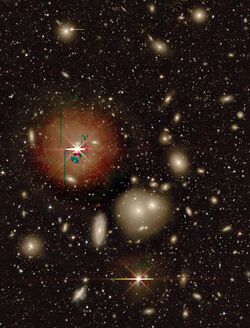Hydra Cluster
Topic: Astronomy
 From HandWiki - Reading time: 3 min
From HandWiki - Reading time: 3 min
Short description: Galaxy cluster in the constellation Hydra
| Hydra Cluster | |
|---|---|
 Central region of Abell 1060 (Hydra Cluster) with legacy surveys. The bright stars are HD 92036 (middle left) and HD 91964 (bottom) | |
| Observation data (Epoch J2000) | |
| Constellation(s) | Hydra |
| Right ascension | 09h 18.0m[1] |
| Declination | −12° 05′[1] |
| Number of galaxies | 157[2] |
| Richness class | 1[3] |
| Bautz–Morgan classification | III[3] |
| Redshift | 0.0548 (16,452 km/s)[1] |
| Distance (co-moving) | 58.3 Mpc (190.1 Mly) h−10.705 |
| X-ray flux | 6.1×10−11 erg s−1 cm−2 (0.5–2 keV)[1] |
| Other designations | |
| Abell 1060 | |
The Hydra Cluster (or Abell 1060) is a galaxy cluster that contains 157 bright galaxies, appearing in the constellation Hydra.[4] The cluster spans about ten million light-years and has an unusually high proportion of dark matter.[5] The cluster is part of the Hydra–Centaurus Supercluster located 158 million light-years from Earth. The cluster's largest galaxies are elliptical galaxies NGC 3309 and NGC 3311 and the spiral galaxy NGC 3312 all having a diameter of about 150,000 light-years.[6] In spite of a nearly circular appearance on the sky, there is evidence in the galaxy velocities for a clumpy, three-dimensional distribution.[7]
References
- ↑ 1.0 1.1 1.2 1.3 "NASA/IPAC Extragalactic Database". Results for Abell 2151. http://ned.ipac.caltech.edu/cgi-bin/nph-objsearch?objname=Hydra+A&extend=no. Retrieved 13 June 2013.
- ↑ "National Optical Astronomy Observatory". Galaxies. http://www.noao.edu/image_gallery/html/im0658.html. Retrieved 19 July 2007.
- ↑ 3.0 3.1 Abell, George O.; Corwin, Harold G., Jr.; Olowin, Ronald P. (May 1989). "A catalog of rich clusters of galaxies" (PDF). Astrophysical Journal Supplement Series 70 (May 1989): 1–138. doi:10.1086/191333. ISSN 0067-0049. Bibcode: 1989ApJS...70....1A. http://articles.adsabs.harvard.edu/cgi-bin/nph-iarticle_query?bibcode=1989ApJS...70....1A&page_ind=0&epage_ind=137&type=PRINTER&data_type=PDF_HIGH&email=&emailsize=500&emailsplit=YES&send=GET&verified=YES. Retrieved 12 March 2012.
- ↑ Wehner and Harris, p.1
- ↑ Nemiroff, R.; Bonnell, J., eds (16 April 2001). "The Hydra Cluster of Galaxies". Astronomy Picture of the Day. NASA. https://apod.nasa.gov/apod/ap010416.html.
- ↑ The Hydra Supercluster An Atlas of the Universe.com
- ↑ The Astrophysical Journal 335: 18–34. December 1988. doi:10.1086/166902. Bibcode: 1988ApJ...335...18F.
Related reading
- Wehner, Elizabeth M. H. and Harris, William E. (10 August 2006) UCD candidates in the Hydra Cluster . ArXiv.org. ApL Letters
- The Hydra Cluster on WikiSky: DSS2, SDSS, GALEX, IRAS, Hydrogen α, X-Ray, Astrophoto, Sky Map, Articles and images
Coordinates: ![]() 10h 36.9m 00s, −27° 32′ 00″
10h 36.9m 00s, −27° 32′ 00″
 |
Licensed under CC BY-SA 3.0 | Source: https://handwiki.org/wiki/Astronomy:Hydra_Cluster1 views | ↧ Download this article as ZWI file
 KSF
KSF
